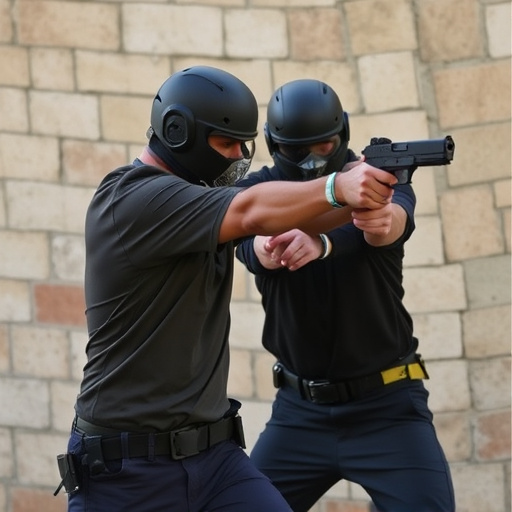Runners seeking personal safety require a compact, lightweight stun gun with close electrode spacing for increased potency, swift deployment, and ergonomic grip. Crafted from high-quality materials, these devices ensure reliability and prioritize user safety without compromising performance, ideal for outdoor adventures like running or hiking. Real-world testing is crucial to evaluate their effectiveness in various scenarios, ensuring quick threat neutralization while minimizing side effects.
In today’s world, personal safety is paramount, especially for outdoor enthusiasts like runners. A compact stun gun can be a powerful tool for deterring potential threats, but its effectiveness hinges on electrode spacing and design. This article explores the critical factors that influence stun gun performance, focusing on compact models tailored for runners’ safety needs. We delve into electrode placement, testing real-world scenarios, and essential safety features, providing insights to ensure maximum protection during outdoor runs.
- Compact Stun Gun Design Considerations for Runners
- Electrode Spacing: Impact on Stun Gun Effectiveness
- Safety Features in Stun Guns for Outdoor Activities
- Optimal Electrode Placement for Maximum Shock
- Testing Stun Gun Performance in Real-World Scenarios
Compact Stun Gun Design Considerations for Runners

When it comes to personal safety, runners often look for compact and lightweight self-defense tools that won’t slow them down. A compact stun gun designed specifically for runners should prioritize ease of carry and minimal impact on their pace. The electrode spacing, a critical factor in any stun gun’s effectiveness, plays a significant role here. A closer electrode spacing ensures faster current flow, increasing the stun’s potency while reducing the energy required to deploy it. This is particularly beneficial for runners who might need a swift response during unexpected encounters.
Additionally, such a stun gun should be ergonomically designed, featuring a grip that allows easy access and control even during a chase or struggle. The overall compactness should not compromise the device’s reliability; thus, careful consideration of materials and manufacturing quality is essential to ensure it functions consistently under various conditions.
Electrode Spacing: Impact on Stun Gun Effectiveness

The electrode spacing on a stun gun plays a significant role in its overall effectiveness, especially when considering its intended use, like personal safety for runners. A compact stun gun designed for portability and ease of carry may have different electrode configurations compared to larger models. Closer electrode spacing can enhance the stun gun’s performance by ensuring more precise and efficient current delivery to the target area, potentially increasing the likelihood of incapacitation quickly.
For a runner seeking personal safety, this means that a compact stun gun with optimally spaced electrodes could provide a powerful but controlled shock, temporarily disabling an assailant without causing significant collateral damage or injuries. This is particularly crucial in high-stress situations where speed and reliability are paramount. Effective electrode spacing allows the stun gun to deliver a powerful electric current, disrupting muscle control and leading to loss of balance or consciousness, all while maintaining user safety.
Safety Features in Stun Guns for Outdoor Activities

When considering a compact stun gun for outdoor activities, such as running or hiking, it’s crucial to look beyond its size and focus on built-in safety features. Many modern stun guns are designed with advanced electrical systems that employ strategic electrode spacing for optimal effectiveness while minimizing risks of unintended discharge. This precise configuration ensures the stun gun delivers a powerful jolt only when intended, reducing the chances of accidental shocks.
Additionally, these devices often incorporate safety mechanisms like motion sensors and programmable settings, allowing users to adjust the intensity of the shock based on their needs and surroundings. For runners or outdoor enthusiasts, this means enhanced personal safety without compromising mobility or convenience, making a compact stun gun an ideal companion for navigating remote trails or urban environments alike.
Optimal Electrode Placement for Maximum Shock

Optimal electrode placement is crucial for maximizing the effectiveness of a stun gun, especially in compact designs intended for runner’s safety. For stun guns, the distance between electrodes needs to be considered carefully. When delivered correctly, an electric shock from a stun device disrupts muscle control, causing the target to lose mobility and balance. To achieve this, electrodes should be placed strategically on both sides of the body, typically targeting the larger muscle groups like the thighs or arms.
Compact stun guns for runners prioritize efficiency and ease of use, often incorporating smaller electrode gaps to ensure a strong shock despite their compact size. This design choice caters to individuals who require immediate safety without compromising power. By understanding the ideal electrode spacing, users can deploy these compact devices effectively in high-risk situations, enhancing personal safety during runs or outdoor activities.
Testing Stun Gun Performance in Real-World Scenarios

Testing stun gun performance in real-world scenarios is a crucial step in evaluating their effectiveness, especially for compact stun guns designed with runner’s safety in mind. These miniature devices are created to be lightweight and easily carried, often fitting into pockets or attached to belts, making them an attractive option for personal protection while running or engaging in outdoor activities. To ensure their reliability, these stun guns undergo rigorous testing that mimics real-life situations.
Researchers simulate various scenarios like close encounters with assailants, providing data on the weapon’s power output and electrode spacing to neutralize threats quickly. The compact size demands precise engineering of the stun gun’s electrodes, ensuring they deliver a powerful jolt while maintaining a safe distance from the user. These tests are vital in determining the device’s performance under stress, its impact on targets, and any potential side effects, thereby offering insights into the stun gun’s overall effectiveness as a safety measure for runners and outdoor enthusiasts.
When considering a compact stun gun designed for runners, optimal electrode spacing and placement are key factors for maximum effectiveness. As discussed, closer electrode spacing enhances shock delivery, ensuring swift incapacitation in real-world scenarios. Safety features, such as smart triggers and reduced risk of accidental discharge, are vital for outdoor activities. By combining these elements with thoughtful design considerations, runners can enhance their personal safety while engaging in outdoor pursuits, choosing a reliable compact stun gun that suits their needs. This ensures both peace of mind and the ability to defend against potential threats effectively.
